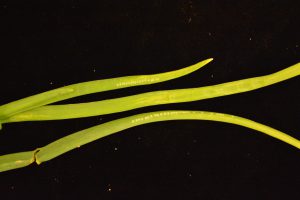Allium Leaf Miner
Allium leaf miner (ALM) feeding/egglaying scars were detected in chives and scallions near Princeton (Mercer Co.), NJ on Friday of this week. This indicates that the second (fall) flight of these flies is now underway, and damage is occurring.
Growers should consider initiating the control method of their choice at this time. Affected crops include chives, scallions, garlic, onions and leeks.
Floating row covers, kept on until the second flight ends will help minimize access to plants. Insecticide applications targeting adults may be helpful as well, although frequency of applications is uncertain. Spinosyn materials (Radiant, Entrust (OMRI approved)), pyrethroids (Mustang Maxx, Warrior), and pyrethrin materials (Pyganic (OMRI approved)), neonicotinoids (Scorpion, Venom) and the insect growth regulator Trigard are labeled for miner control.
Adult activity and observations of feeding will be reported on in the IPM Update as they occur. At this time, all growers should respond to the second adult generation. We will attempt to identify the end of the second flight so that growers know when the risk of infestation has abated.

